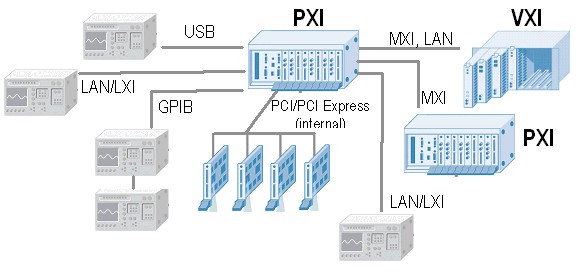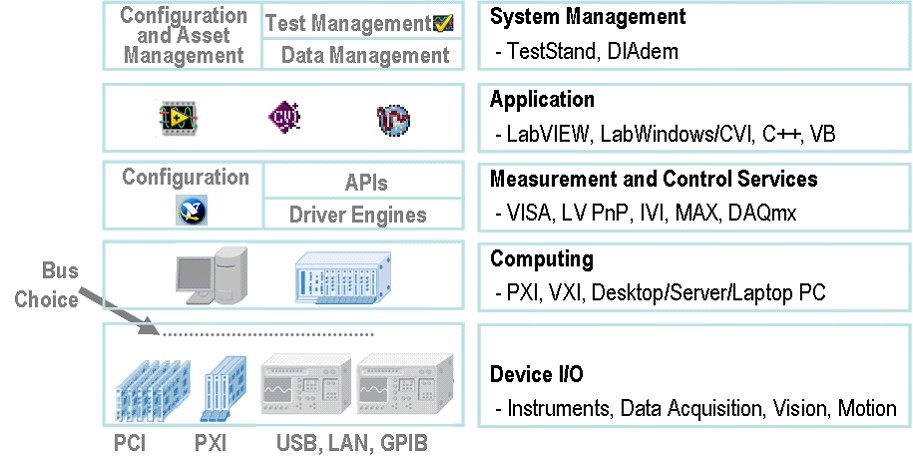Benefits of Hybrid Systems
Contents
- Introduction
- Greater System Flexibility
- Extended System Longevity
- Available Instrumentation Buses
- Conclusion
Introduction
When you design a test system, you have various factors to consider, one of which is the instrumentation bus or platform used. While many instrument manufacturers promote one bus over others when designing a system, it is often beneficial to combine multiple instrumentation buses and platforms to design a hybrid system. Hybrid test systems combine components from multiple ATE platforms including PXI, VXI, USB, LAN and GPIB. Each of these buses has its own benefits that might make it more useful for a particular measurement need. No bus, however, is perfect for all needs and applications. With the variety of instrumentation buses available, hybrid systems allow you to select the appropriate instruments for your specific needs based on factors including measurement functionality, bandwidth, latency, performance, and connectivity. By using components from multiple platforms to build a hybrid system, you gain flexibility for the system and extend the longevity of your test system.

Figure 1. Example hybrid system combines components from various buses and platforms.
Greater System Flexibility
Because a variety of buses are available, each with its own strengths, hybrid systems are a good option for test systems since they provide greater system flexibility. When you choose only one bus or platform for a system, you are limited to the instrumentation available for that bus. This might prevent you from using another instrument that is better suited to your system needs. When selecting instruments, you want to choose instruments based on specifications like performance, accuracy, and measurement availability. By removing the restriction of using only one bus for the system, you open up the possibilities for instrumentation. Some buses and platforms provide highly specialized instrumentation while others provide instruments at a better price and performance combination. Thus, a hybrid system enables you to combine instruments from different buses and platforms to take advantage of these strengths.
Successfully implementing a hybrid system requires a modular system architecture. This ensures that you are able to combine disparate buses into one seamless system. The architecture enables interconnectivity between the buses as well as software integration. One of the major of benefits in addition to the ability to integrate buses is the ability to add more instruments and buses in the future without re-architecting the system. For instance, if you had a PXI system that connected to a GPIB stand-alone instrument, you could easily add more PXI instruments to the chassis or stand-alone instruments through the PXI connectivity to other buses including USB, LAN, and GPIB. Then, only specific test programs that require the use of these new instruments would need to be added to the system. This provides you with a test system that is able to adjust to your changing needs and requirements.
Figure 2. Modular test system architecture enables the combining of multiple platforms into one system
Extended System Longevity
A common challenge with managing test systems is balancing performance, scalability, cost, and system longevity. In some cases, the desired test system lifecycle is longer than the lifecycles of the test components used. To extend system life, you can keep a stock of these test components, pay a premium for end-of-life test components, or redesign the whole test system in an effort to fight obsolescence. While these processes help extend system life, they are not only cumbersome and expensive, but they also force you to trade longevity for scalability, flexibility, and possibly cost or performance. Instead, you can maximize the longevity of your system by using hybrid test systems. Hybrid systems simplify technology refreshment by easing the process of combing existing equipment with newer technologies. This way you maximize use out of both existing hardware and software but can still take advantage of other technologies. Because hybrid systems give you the freedom to use a variety of buses and platforms together, you are not limited to stay with the particular bus of your older equipment.
With a hybrid test system, you can replace or upgrade instruments with limited changes in a few layers instead of completely redesigning a system or sifting through the whole test program to change code. This is possible through the measurement and control services layer which contains the tools that bridge hardware and software and provide support for a variety of bus technologies through a configuration manager, driver engines, and flexible high-level application programming interfaces (APIs). Through instrument drivers you can easily interact with the instruments through a high-level API to simplify programming. In addition, LabVIEW and LabWindows/CVI Plug and Play instrument drivers or Interchangeable Virtual Instrument (IVI) drivers provide bus and controller interchangeability or instrument interchangeability. This minimizes your maintenance and upgrade impact. When developing a hybrid system, you can choose from many connectivity options available through the controller hardware and drivers to support various connectivity needs. Select the control method for the different platforms carefully because your choice affects your ease in expanding and scaling your system for future needs.
Available Instrumentation Buses
A variety of instrumentation buses are available for stand-alone instruments including GPIB, USB, LAN including LXI, and serial. The various instrumentation buses have differing strengths making some more suitable for certain applications than others. With GPIB, users benefit from a proven instrumentation bus technology and a wide variety of available instrumentation. USB provides you with the benefits of the wide availability, easy connectivity, and high throughput. With LAN/LXI, users are able to support distributed needs and address distance needs. Providing 80 MB/s maximum shared bandwidth, the modular VMEbus has served military/aerospace applications well with specialized instrumentation. The widespread modular PCI bus, an internal PC bus, benefits from PC ubiquity and provides low latency and high bandwidth at 132 MB/s. PCI Express, an evolution of PCI, meets growing bandwidth needs while still providing complete software compatibility with PCI. PCI Express provides dedicated bandwidth, unlike PCI, to each device through a basic communication lane of 250 Mbytes/s in each direction up to 4 Gbytes/s.
The open VXI platform builds on the VMEbus by providing additional timing and synchronization lines. In a similar way, the open PXI platform builds on the PCI bus by adding modular Eurocard packaging, specialized synchronization buses, and key software features. PXI is both a high-performance and low-cost platform for test and measurement applications. In addition, PXI integrates PCI Express in the backplane with PXI Express, increasing the available bandwidth from 132 MB/s to 6 GB/s for a more than 45X improvement. Already heavily used as a platform for modular instrumentation, PXI, with this enhanced performance, can reach into many new application areas, many of which were previously only served by expensive and proprietary hardware.
Standalone instruments can be beneficial in that they might provide specialized functionality or performance. These instruments, however, are vendor-defined, proprietary instruments. As a result, developers will face limited integration and expandability and are forced to work with a proprietary software model. With modular instrumentation buses, developers can take advantage of open, multi-vendor standards and software flexibility to create a user-defined solution for their specific application needs. Modular instrumentation buses provide higher throughput and lower latency in comparison to stand-alone instrumentation buses. This allows users to meet many application needs including high-speed data streaming or high channel count. By taking advantage of an open software model and PC processing power, users can extract all measurements needed from the data provided by modular instruments. This gives users the flexibility to design a system with the specific components required and to scale the application when needed. As a result, when designing hybrid systems, it is often appropriate to use PXI as the computing center due to its timing and synchronization capabilities and low latency to measurement devices. In addition, it also has a high Windows native slot count, which allows you to add buses and access them from the PC without the need for special drivers.

Figure 3. Bandwidth and latency comparison of various buses.
In conclusion, with the wealth of buses and platforms available, hybrid systems allow you to combine them to suit your specific needs. Hybrid systems provide increased flexibility by allowing you to select the specific instruments for your system regardless of the bus and to expand the system as system requirements change. In addition, hybrid systems help you to extend test system longevity by enabling you to use older equipment with newer technology and minimizing the impact of maintenance and upgrades. As a result, hybrid systems are a beneficial approach to designing test systems.
Conclusion
NI, a leader in automated test, is committed to providing the hardware and software products engineers need to create these next generation test systems.
